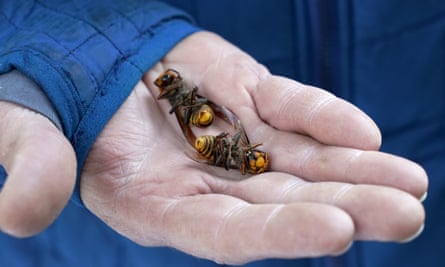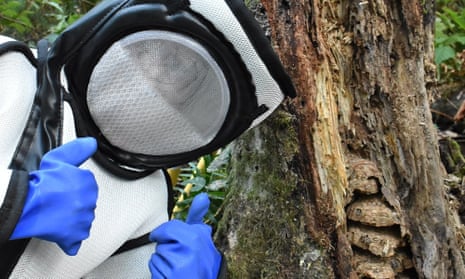A third Asian giant hornet nest was discovered in Washington state, a day after entomologists discovered a second.
The Washington state agriculture department tweeted on Saturday that it planned to eradicate the nest and would have more updates soon.
Asian giant hornets are an invasive species also known as murder hornets because they prey on smaller insects. Their nests are difficult to locate, as they tend to be in forested areas. In the US, they pose a particular threat to native hornet species and to honeybees.
Left unchecked, the hornets can destroy a honeybee hive in hours, feeding on larvae and decapitating bees in what scientists call a “slaughter phase”. The hornets then feed severed body parts to their own young.
They can also harm humans, even causing fatalities. One entomologist has described the feeling of being stung by a murder hornet as like “having hot tacks pushed into my flesh”. They can also eject venom.

Last year, Chris Looney, a Washington state entomologist tasked with vacuuming up the hornets, told the Guardian they were “pretty intimidating, even for an inch-and-a-half insect … they give me the willies.”
On 26 August, Washington state officials announced that they had destroyed the first nest of the season, near the town of Blaine on the border with Canada.
That nest was found in the base of a dead alder tree in rural Whatcom county, roughly two miles from a nest eradicated last October and about a quarter of a mile from where a resident reported a live sighting on 11 August this year.
Officials were able to locate the first nest of 2021 after attaching trackers to three hornets. The eradication process involved vacuuming 113 hornets from the nest and removing bark and decayed wood near the base of the tree to reveal nine layers of comb.
The portion of the tree that contained the nest was cut and transported to Washington State University Extension in Bellingham for further analysis. In total, the nest contained nearly 1,500 hornets in various stages of development, authorities said.
“While we are glad to have found and eradicated this nest so early in this season, this detection proves how important public reporting continues to be,” said Sven Spichiger, Washington state’s managing entomologist, about the first nest.
“We expect there are more nests out there and, like this one, we hope to find them before they can produce new queens. Your report may be the one that leads us to a nest.”
